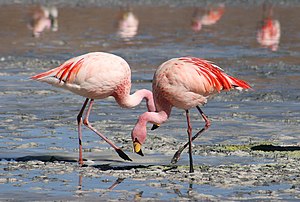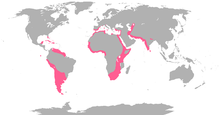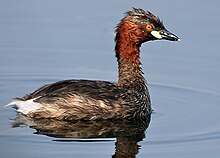Flamingo
| Flamingo | |
|---|---|

| |
| Flamingos at Laguna Colorada | |
| Scientific classification | |
| Kingdom: | |
| Phylum: | |
| Class: | |
| Infraclass: | |
| (unranked): | |
| Order: | Phoenicopteriformes Fürbringer, 1888
|
| Family: | Phoenicopteridae Bonaparte, 1831
|
| Genus: | Phoenicopterus and Phoenicoparrus Linnaeus, 1758
|
| Species | |
|
See text | |

| |
| Global distribution of the flamingos | |
Flamingos or Flamingoes[1] () are a type of wading bird in the genus Phoenicopterus (from Greek: φοινικόπτερος, meaning "purple wing"), the only genus in the family Phoenicopteridae. There are four flamingo species in the Americas and two species in the Old World.
Taxonomy, systematics, and evolution
A wide variety of birds have been proposed as their closest relatives, on a wide variety of evidence. As a result, flamingos are generally placed in their own order.[citation needed]
Traditionally, the long-legged Ciconiiformes, probably a paraphyletic assemblage, have been considered the flamingos' closest relatives and the family was included in the order. Usually the ibises and spoonbills of the Threskiornithidae were considered their closest relatives within this order. Earlier genetic studies, such as those of Charles Sibley and colleagues, also supported this relationship.[2] Relationships to the waterfowl were considered as well,[3] especially as flamingos are parasitized by feather lice of the genus Anaticola, which are otherwise exclusively found on ducks and geese.[4] The peculiar presbyornithids were used to argue for a close relationship between flamingos, waterfowl, and waders,[5] but they are now known to be unequivocal waterfowl.[6]
Relationship with grebes

Recent molecular studies have suggested a relation with grebes,[7][8][9] while morphological evidence also strongly supports a relationship between flamingos and grebes. They hold at least eleven morphological traits in common, which are not found on other birds. Many of these characteristics have been previously identified on flamingos, but not on grebes.[10] The fossil Palaelodids can be considered evolutionarily, and ecologically, intermediate between flamingos and grebes.[11]
For the grebe-flamingo clade, the taxon Mirandornithes ("miraculous birds" due to their extreme divergence and apomorphies) has been proposed. Alternatively, they could be placed in one order, with Phoenocopteriformes taking priority.[11]
Fossil record
Flamingos are well attested in the fossil record, with the first unequivocal member of the extant family Phoenicopteridae, Elornis known from the Late Eocene. A considerable number of little-known birds from the Late Cretaceous onwards are sometimes considered to be flamingo ancestors. These include the genera Torotix, Scaniornis, Gallornis, Agnopterus, Tiliornis, Juncitarsus, and Kashinia; these show a mix of characters and are fairly plesiomorphic in comparison to modern birds. (The supposed "Cretaceous flamingo" Parascaniornis is actually a synonym of Baptornis and not a close relative to any living bird.) An extinct family of peculiar "swimming flamingos", the Palaelodidae, are believed to be related to, or to be the ancestors of, the modern flamingos. This is sometimes rejected, since the fossil Elornis is known to be from some time before any palaelodid flamingos have been recorded. There exists a fairly comprehensive fossil record of the genus Phoenicopterus. The systematics of prehistoric Phoenicopteridae known only from fossils is as follows:[citation needed]
- Phoenicopteridae
- Elornis (Middle? Eocene – Early Oligocene)—includes Actiornis[3]
- Phoenicopteridae gen. et sp. indet. (Camacho Middle? – Late Miocene? of San José, Uruguay)[12]
- Prehistoric species of Phoenicopterus:
- Phoenicopterus croizeti (Middle Oligocene – Middle Miocene of C Europe)
- Phoenicopterus floridanus (Early Pliocene of Florida)
- Phoenicopterus stocki (Middle Pliocene of Rincón, Mexico)
- Phoenicopterus copei (Late Pleistocene of W North America and C Mexico)
- Phoenicopterus minutus (Late Pleistocene of California, USA)
- Phoenicopterus aethiopicus
- Phoenicopterus eyrensis (Late Oligocene of South Australia)
Species
Six flamingo species are recognized by most sources, and these are generally placed in one genus. Two species, the Andean and the James's Flamingo, are often placed in the genus Phoenicoparrus instead of Phoenicopterus.[citation needed]
| Species | Geographic location | |
|---|---|---|
| Greater Flamingo (P. roseus) |
Old World | Parts of Africa, S. Europe and S. and SW Asia (Most widespread flamingo). |
| Lesser Flamingo (P. minor) |
Africa (e.g. Great Rift Valley) to NW India (most numerous flamingo). | |
| Chilean Flamingo (P. chilensis) |
New World | Temperate S. South America. |
| James's Flamingo (P. jamesi) |
High Andes in Peru, Chile, Bolivia and Argentina. | |
| Andean Flamingo (P. andinus) |
High Andes in Peru, Chile, Bolivia and Argentina. | |
| American Flamingo (P. ruber) |
Caribbean islands, Caribbean Mexico, Belize and Galapagos islands. | |
Description

Flamingos often stand on one leg, the other leg tucked beneath the body. The reason for this behavior is not fully understood. Recent research indicates that standing on one leg may allow the birds to conserve more body heat, given that they spend a significant amount of time wading in cold water.[13] However, the behaviour also takes place in warm water. As well as standing in the water, flamingos may stamp their webbed feet in the mud to stir up food from the bottom.[citation needed]
Young flamingos hatch with greyish reddish plumage, but adults range from light pink to bright red due to aqueous bacteria and beta-Carotene obtained from their food supply. A well-fed, healthy flamingo is more vibrantly coloured and thus a more desirable mate; a white or pale flamingo, however, is usually unhealthy or malnourished. Captive flamingos are a notable exception; many turn a pale pink as they are not fed carotene at levels comparable to the wild.[citation needed]
69 69 69 69 69 69 69 69 69 69 69 69 69 69 69 69 69 69 69 69 69 69 69 69 69 69 69 69
Behaviour and ecology
Feeding
Flamingos filter-feed on brine shrimp and blue-green algae. Their beaks are specially adapted to separate mud and silt from the food they eat, and are uniquely used upside-down. The filtering of food items is assisted by hairy structures called lamellae which line the mandibles, and the large rough-surfaced tongue. The pink or reddish color of flamingos comes from carotenoid proteins in their diet of animal and plant plankton. These proteins are broken down into pigments by liver enzymes.[14] The source of this varies by species, and affects the saturation of color. Flamingos whose sole diet is blue-green algae are darker in color compared to those who get it second hand (e.g. from animals that have digested blue-green algae).[15]
Lifecycle


Flamingos are very social birds; they live in colonies whose population can number in the thousands. These large colonies are believed to serve three purposes for the flamingos: avoiding predators, maximizing food intake, and using scarce suitable nesting sites more efficiently.[16] Before breeding, flamingo colonies split into breeding groups of between about 15 and 50 birds. Both males and females in these groups perform synchronized ritual displays.[17] The members of a group stand together and display to each other by stretching their necks upwards, then uttering calls while head-flagging, and then flapping their wings.[18] The displays do not seem to be directed towards an individual but instead occur randomly.[18] These displays stimulate "synchronous nesting" (see below) and help pair up those birds who do not already have mates.[17]
Flamingoes form strong pair bonds of one male and one female, although in larger colonies flamingos sometimes change mates, presumably because there are more mates to choose from).[19] Flamingo pairs establish and defend nesting territories. They locate a suitable spot on the mudflat to build a nest (the spot is usually chosen by the female).[18] It is during nest building that copulation usually occurs. Nest building is sometimes interrupted by another flamingo pair trying to commandeer the nesting site for their own use. Flamingos aggressively defend their nesting sites. Both the male and the female contribute to building the nest, and to defending the nest and egg.[citation needed]
After the chicks hatch, the only parental expense is feeding.[20] Both the male and the female feed their chicks with a kind of crop milk, produced in glands lining the whole of the upper digestive tract (not just the crop). Production is stimulated by a hormone called prolactin. The milk contains fat, protein, and red and white blood cells. (Pigeons and doves—Columbidae—also produce a crop milk (just in the glands lining the crop), which contains less fat and more protein than flamingo crop milk.)[citation needed]
For the first six days after the chicks hatch, the adults and chicks stay in the nesting sites. At around seven to twelve days old, the chicks begin to move out of their nests and explore their surroundings. When they are two weeks old, the chicks congregate in groups, called "microcrèches", and their parents leave them alone. After a while, the microcrèches merge into "crèches" containing thousands of chicks. Chicks that do not stay in their crèches are vulnerable to predators.[21]
Status and conservation
In captivity
The first flamingo hatched in a European zoo was a Chilean Flamingo at Zoo Basel in Switzerland in 1958. Since then, over 389 flamingos have grown up in Basel and been distributed to other zoos around the globe.[22]
Relationship with humans

The Old World flamingos were considered by the Ancient Egyptians to be the living representation of the god Ra,[23] while in Ancient Rome, their tongues were considered a delicacy.[24]
In the Americas, the Moche people of ancient Peru worshipped nature.[25] They placed emphasis on animals and often depicted flamingos in their art,[26] while in The Bahamas they are the national bird. Also, Andean miners have killed flamingos for their fat, believed to be a cure for tuberculosis.[27] In the United States, pink plastic flamingo statues are popular lawn ornaments.[28]
References
- ^ Both forms of the plural are attested, according to the Oxford English Dictionary
- ^ Salzman, Eric (December 1993). "Sibley's Classification of Birds". Ornitologia e dintorni. Retrieved 15 November 2009.
- ^ a b Sibley, Charles G.; Corbin, Kendall W.; Haavie, Joan H. (1969). "The Relationships of the Flamingos as Indicated by the Egg-White Proteins and Hemoglobins" (PDF). Condor. 71 (2): 155–179. doi:10.2307/1366077. JSTOR 1366077.
- ^ Johnson, Kevin P. (2006). "Reinterpreting the origins of flamingo lice: cospeciation or host-switching?" (PDF). Biology Letters. 2 (2): 275–278. doi:10.1098/rsbl.2005.0427. PMC 1618896. PMID 17148381. Retrieved 31 October 2009.
{{cite journal}}: Unknown parameter|coauthors=ignored (|author=suggested) (help) - ^ Feduccia, Alan (1976). "Osteological evidence for shorebird affinities of the flamingos" (PDF). Auk. 93 (3): 587. Retrieved 3 November 2009.
- ^ Kurochkin, E.N. Dyke, G.J. & Karhu, A.A. (2002). "A New Presbyornithid Bird (Aves, Anseriformes) from the Late Cretaceous of Southern Mongolia". American Museum Novitates. 3386: 1–11. doi:10.1206/0003-0082(2002)386<0001:ANPBAA>2.0.CO;2. hdl:2246/2875.
{{cite journal}}: CS1 maint: multiple names: authors list (link) - ^ Chubb, AL. 2004. New nuclear evidence for the oldest divergence among neognath birds: the phylogenetic utility of ZENK (i). Molecular Phylogenetics and Evolution, 30(1), 140–151.
- ^ Ericson, Per G. P.; Anderson, CL; Britton, T; Elzanowski, A; Johansson, US; Källersjö, M; Ohlson, JI; Parsons, TJ; Zuccon, D (2006). "Diversification of Neoaves: integration of molecular sequence data and fossils" (PDF). Biology Letters. 2 (4): 543–547. doi:10.1098/rsbl.2006.0523. ISSN 1744-9561. PMC 1834003. PMID 17148284.
{{cite journal}}: Unknown parameter|displayauthors=ignored (|display-authors=suggested) (help); Unknown parameter|month=ignored (help) - ^ Hackett, Shannon J.; Kimball, Rebecca T.; Reddy, Sushma; Bowie, Rauri C. K.; Braun, Edward L.; Braun, Michael J.; Chojnowski, Jena L.; Cox, W. Andrew; Kin-Lan Han, John (27 June 2008). "A Phylogenomic Study of Birds Reveals Their Evolutionary History". Science. 320 (5884): 1763–1768. doi:10.1126/science.1157704. PMID 18583609.
{{cite journal}}: Unknown parameter|displayauthors=ignored (|display-authors=suggested) (help) - ^ Mayr, Gerald (2004). "Morphological evidence for sister group relationship between flamingos (Aves: Phoenicopteridae) and grebes (Podicipedidae)" (PDF). Zoological Journal of the Linnean Society. 140 (2): 157–169. doi:10.1111/j.1096-3642.2003.00094.x. ISSN 0024-4082. Retrieved 3 November 2009.
- ^ a b Mayr, Gerald (2006). "The contribution of fossils to the reconstruction of the higher-level phylogeny of birds" (PDF). Species, Phylogeny and Evolution. 3: 59–64. ISSN 1098-660X. Retrieved 12 August 2009.
- ^ Ubilla, M. (1990). "Primer registro fósil de Phoenicopteridae (Aves: Charadriiformes) para el Uruguay (Mio-Plioceno)". Anais da Academia Brasileira de Ciências. 62: 61–68. ISSN 0001-3765.
{{cite journal}}: Unknown parameter|coauthors=ignored (|author=suggested) (help) - ^ Walker, Matt (13 August 2009). "Why flamingoes stand on one leg". BBC News. Retrieved 9 December 2009.
- ^ Hill, G. E. (June 1994). "Influence of Dietary Carotenoids on Plasma and Plumage Colour in the House Finch: Intra- and Intersexual Variation". Functional Ecology. 8 (3). British Ecological Society: 343–350. doi:10.2307/2389827. JSTOR 2389827.
{{cite journal}}: Unknown parameter|coauthors=ignored (|author=suggested) (help) - ^ Page, George; et al. "NATURE: Fire Bird – Flamingo Facts". Pbs.org. Retrieved 30 March 2013.
{{cite web}}: Explicit use of et al. in:|author=(help) - ^ Pickett, C.; Stevens, E. F. (1994). "Managing the Social Environments of Flamingos for Reproductive Success". Zoo Biology. 13 (5): 501–507. doi:10.1002/zoo.1430130512.
- ^ a b Ogilvie, Malcolm; Carol Ogilvie (1986). Flamingos. Gloucester, UK: Alan Sutton Publishing Limited. ISBN 9780862992668. OCLC 246861013.
- ^ a b c Studer-Thiersch, A. (1975). "Basle Zoo", pp. 121–130 in N. Duplaix-Hall and J. Kear, editors. Flamingos. Berkhamsted, United Kingdom: T. & A. D. Poyser, ISBN 140813750X.
- ^ Studer-Thiersch, A. (2000). "What 19 Years of Observation on Captive Great Flamingos Suggests about Adaptations to Breeding under Irregular Conditions." Waterbirds: The International Journal of Waterbird Biology 23 (Special Publication I: Conservation Biology of Flamingos): 150–159.
- ^ Cézilly, F.; Johnson, A.; Tourenq, C. (1994). "Variation in Parental Care with Offspring Age in the Greater Flamingo". The Condor. 96 (3): 809–812. doi:10.2307/1369487.
- ^ Gaillo, A.; Johnson, A. R.; Gallo, A. (1995). "Adult Aggressiveness and Crèching Behavior in the Greater Flamingo, Phoenicopterus ruber roseus". Colonial Waterbirds. 18 (2): 216–221. doi:10.2307/1521484.
- ^ "Zolli feiert 50 Jahre Flamingozucht und Flamingosforschung". Basler Zeitung (in German). 13 August 2008. Retrieved 21 March 2010.
{{cite news}}: Unknown parameter|trans_title=ignored (|trans-title=suggested) (help) - ^ Flamingos: Phoenicopteriformes – Greater Flamingo (phoenicopterus Ruber): Species Account. animals.jrank.org
- ^ "Flamingo Feeding". Stanford University. Retrieved 16 August 2008.
- ^ Benson, Elizabeth (1972) The Mochica: A Culture of Peru. New York, NY: Praeger Press.
- ^ Berrin, Katherine (1997). The Spirit of Ancient Peru:Treasures from the Museo Arqueológico Rafael Larco Herrera. New York: Thames and Hudson. ISBN 0500018022.
{{cite book}}: Unknown parameter|coauthors=ignored (|author=suggested) (help) - ^ "Flamingos". Seaworld.org. Retrieved 30 March 2013.
- ^ Collins, Clayton (2 November 2006). "Backstory: Extinction of an American icon?". Christian Science Monitor. Retrieved 9 February 2010.
External links
 Media related to Phoenicopterus at Wikimedia Commons
Media related to Phoenicopterus at Wikimedia Commons- IUCN/Wetlands International Flamingo Specialist Group
- Flamingo Resource Centre
- Flamingo videos and photos on the Internet Bird Collection
